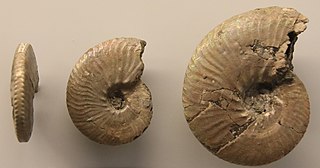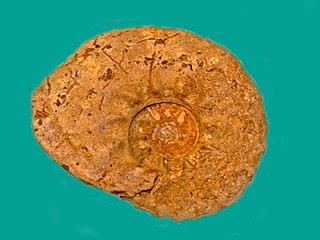Related Research Articles

Goniatites is a genus of extinct cephalopods belonging to the family Goniatitidae, included in the superfamily Goniatitaceae. Hibernicoceras and Hypergoniatites are among related genera.

Australiceras is an extinct ammonite genus from the upper part of the Early Cretaceous, Aptian stage, included in the family Ancyloceratidae.

Ammonoceratites is an extinct genus of ammonoid cephalopod known from the Albian of British Columbia, Madagascar, New Zealand, and Japan, included in the Lytoceratidae.
Anahamulina is an extinct ammonoid cephalopod genus from the Lower Cretaceous. Named by Hyatt, 1900, Anahamulina is included in the family Ptychoceratidae, which is part of the Turrilitaceae.

Anahoplites is a genus of rather involute, compressed hoplitid ammonites with flat sides, narrow flat or grooved venters, and flexious ribs or striae arising from weak umbilicle tubercles that end in fine dense ventrolateral nodes. The elements of their sutures are short, wide and jaggedy. Specimens of Annahoplites have diameters typically in the range of 4–6 centimetres (1.6–2.4 in) although some with diameters of as much as 19 centimetres (7.5 in) have been reported. The genus lived during the Cretaceous, from the Middle to the late Albian.
Arctocephalites is an extinct ammonitic cephalopod genus from the Middle Jurassic with a wide northern distribution belonging to the stephanoceratacean family, Cardioceratidae.

Argonauticeras is an extinct ammonoid cephalopod genus that lived during the latter part of the Early Cretaceous, included in the Lytoceratida and found in lower and possibly middle Aptian marine sediments. It has been thought of as a subgenus of Ammonoceratites.

Barroisiceras is an acanthoceratacean ammonite from the Upper Cretaceous, Coniacian, included in the family Collignoniceratidae.
Berniceras is an extinct ammonite genus from the order Ammonitida that lived during the early Oxfordian stage of the Late Jurassic. Berniceras is included in the ammonite family, Oppeliidae.
Anisoceratidae is an extinct family of heteromorph ammonites which belong to the Ancyloceratina superfamily Turrilitoidea. Members of the family range is from the lower Albian to the upper Turonian. The family is possibly derived from a member of the Hamitidae.
Austrotrachyceras is a genus belonging to the extinct subclass of cephalopods known as ammonites. Specifically it belongs in the order Ceratitida.
Euaptetoceras is an evolute hildoceratoid ammonite from the lower Middle Jurassic, included in the family Hammatoceratidae and the subfamility Hammatoceratinae. The genus may be a junior synonym for Eudmetoceras of Buckman, 1920.
Phaulostephanus is an extinct genus from the ammonoid family Stephanoceratidae, which is part of the ammonitid superfamily Stephanoceratoidea, that lived during the early Middle Jurassic.

Normannites is a strongly ribbed evolute Middle Jurassic genus of ammonite included in the stephanoceratoid family Stephanoceratidae.
Crucilobiceras is an ammonoid cephalopod genus from the Lower Jurassic belonging to the eoderoceratoidean family Eoderoceratidae. Cruciliboceras has an evolute shell, such that all whorls are well exposed, with persistent radial ribbing and with spines or tubercles on the outer, ventral, rim, and in some, tubercles in the inner, umbilical, rim. The genus Crucilobiceras is commonly found along the Jurassic Coast of England.

Neocomites is a genus of ammonite from the Lower Cretaceous, Berriasian to Hauterivian, and type genus for the Neocomitidae.
Saxoceras is a genus of very evolute schlotheimiid ammonoids from the Lower Jurassic.
Melchiorites is a desmoceratid ammonite genus included in the subfamily Puzosiinae. Member species are characterized by an essentially evolute shell in which the early whorls are smooth, with sinuous radial or oblique constrictions but in which later whorls have feeble intermediate ribs on the outer part of the sides and venter.
Olenekoceras is an ammonoid cephalopod from the Lower Triassic included in the ceratitid family Sibiritidae, once included in the Noritaceae but now in the Ceratitaceae.

Parkinsoniidae is a family of ammonites belonging to the order Ammonitida. The cephalopod family lived from the Bajocian stage to the Bathonian age of the Middle Jurassic.
References
- Notes
- 1 2 Sepkoski, Jack (2002). "Sepkoski's Online Genus Database" . Retrieved 2014-05-28.
- ↑ "Paleobiology Database - Dagnoceras" . Retrieved 17 December 2021.
- Bibliography
- Arkell, et al., 1957. Treatise on Invertebrate Paleontology Part L, Mesozoic Ammonoidea. Geological Society of America.